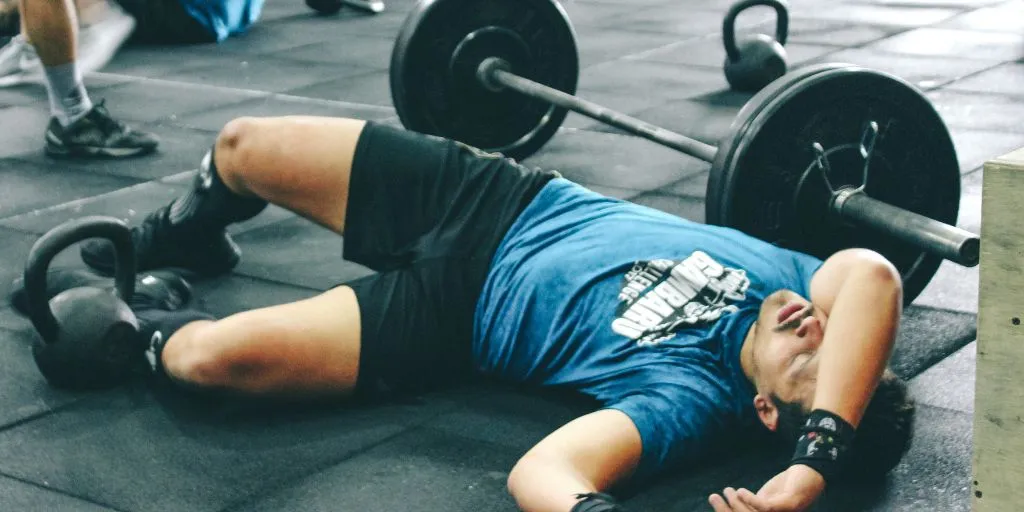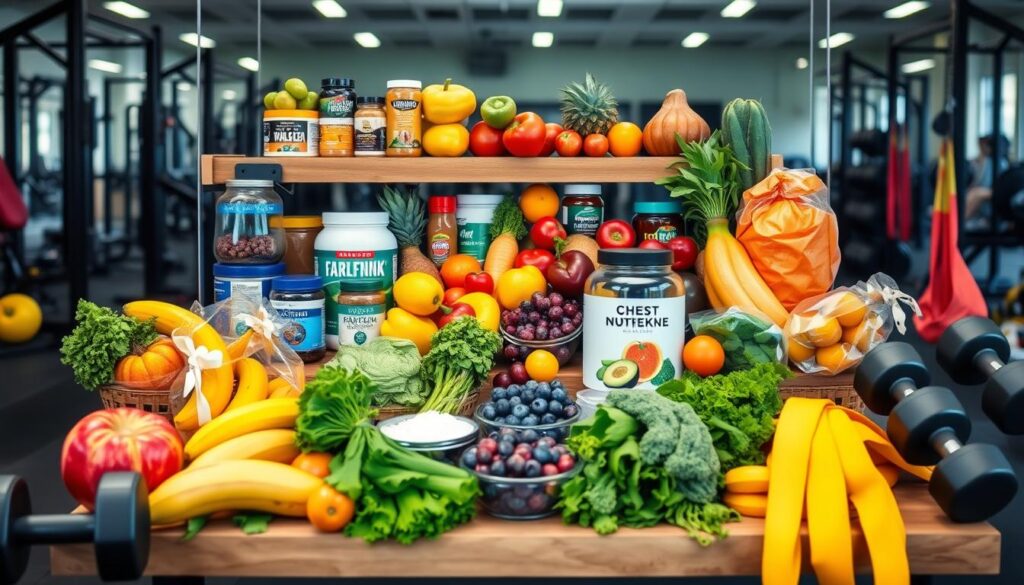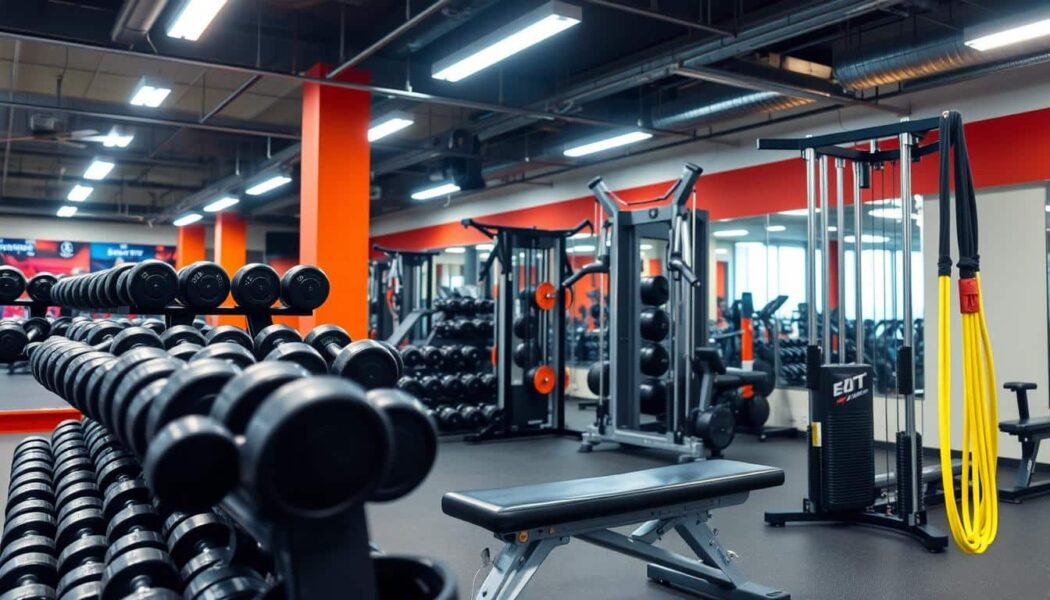Boost Gains with Proven, Top-Rated Chest and Shoulder Exercise Tips!
Every fitness journey has a defining moment. For me, it was realizing that chest and shoulder exercises aren’t just about looking good. They’re about feeling powerful, confident, and strong. The transformation begins when you understand that these muscle groups are more than aesthetic goals; they’re your body’s foundation of strength.
Physique-minded individuals recognize the chest muscle group’s prominent position at the top of the torso. Your chest and shoulder exercises can unlock a new level of physical performance. This is true whether you’re an athlete, fitness enthusiast, or someone seeking improved daily functionality.
Strategic chest and shoulder exercises provide more than muscle definition. They enhance your body’s biomechanical performance. This improves posture, reduces injury risks, and boosts overall athletic performance. With the right approach, you can transform your upper body strength.
Table of Contents
Understanding Chest and Shoulder Anatomy
Your chest and shoulder muscles are key to upper body strength. Knowing how they work helps you exercise better and avoid injuries.
The human body has about 650 named skeletal muscles. The chest and shoulder areas are very detailed. These muscles are a big part of how well we move and perform physically.
Key Muscles Involved
Your chest muscles mainly include two big groups:
- Pectoralis Major: The biggest chest muscle, it helps move arms horizontally
- Pectoralis Minor: Helps keep the shoulder blade stable
Shoulder muscles, or deltoids, have three parts:
- Anterior (Front) Deltoid
- Lateral (Side) Deltoid
- Posterior (Rear) Deltoid
Importance of Proper Form
Doing chest and shoulder exercises right is very important. About 60% of gym users don’t know how to do them correctly. This can really affect how well you train.
“Attentional focus during exercises can increase muscle growth by up to 15%.” – Fitness Research Institute
| Muscle Group | Primary Function | Key Exercise |
|---|---|---|
| Pectoralis Major | Horizontal Adduction | Bench Press |
| Anterior Deltoid | Shoulder Flexion | Overhead Press |
| Pectoralis Minor | Scapula Stabilization | Push-Ups |
Understanding muscle anatomy is the first step to effective chest and shoulder exercises. Spend time learning the right techniques to get the most out of your workouts.
Benefits of Chest and Shoulder Exercises
Starting your fitness journey is easier when you know the benefits of chest and shoulder exercises. These workouts do more than just make your muscles look good. They improve your overall health and fitness.
Doing chest and shoulder exercises regularly has many benefits. They help you build muscle, improve coordination, and keep you healthy for the long term.
- Dramatically increases upper body functional strength
- Enhances overall muscle coordination
- Supports long-term physical health
Enhancing Muscle Strength
Chest and shoulder exercises are key for building strong muscles. The Physical Activity Guidelines suggest doing strength training at least twice a week. This helps you build muscle and get stronger.
Improving Posture
Working out your chest and shoulders helps fix bad posture. Strengthening these muscles can align your spine and lower pain risks. It also makes you stand up straight, boosting your confidence and safety.
Boosting Athletic Performance
Athletes know that chest and shoulder exercises are essential for top performance. These workouts improve your power, speed, and overall athletic skills. They help you perform better, whether you’re a casual athlete or a pro.
“Strength does not come from physical capacity. It comes from an indomitable will.” – Mahatma Gandhi
Adding chest and shoulder exercises to your workout routine opens up new ways to improve your fitness. It goes beyond just doing the usual exercises.
Essential Chest and Shoulder Exercises
Building a strong upper body needs the right chest and shoulder exercises. These exercises target many muscles at once. Learning the best techniques can make your workouts better and help you see muscle growth and strength.
Creating a good chest and shoulder workout means using exercises that work different muscles well. It’s also important to keep the right form. Let’s look at some key movements that can boost your fitness.
Push-Ups: The Classic Choice
Push-ups are a key part of chest and shoulder workouts. They work many muscles at once, giving great strength benefits. Here are some variations to try:
- Standard push-ups for overall chest development
- Wide-grip push-ups to target outer chest muscles
- Diamond push-ups for triceps and inner chest engagement
Dumbbell Press Variations
Dumbbell presses are versatile for chest and shoulder training. They let you move your arms more and fix muscle imbalances.
| Exercise Type | Sets | Reps | Training Goal |
|---|---|---|---|
| Incline Dumbbell Press | 3-4 | 8-12 | Muscle Hypertrophy |
| Flat Dumbbell Press | 3-4 | 8-12 | Overall Chest Development |
| Decline Dumbbell Press | 3-4 | 8-12 | Lower Chest Targeting |
Lateral Raises for Defined Shoulders
Lateral raises are key for strong shoulders. It’s important to do them right to work the muscles well and avoid injury. Start with lighter weights to get your form right before adding more weight.
“Consistency and proper technique are more important than lifting heavy weights.”
Adding these chest and shoulder exercises to your routine will boost your strength and muscle shape. It will also improve your upper body’s performance. Always listen to your body and increase the challenge slowly.
Top Tools for Chest and Shoulder Workouts
Choosing the right equipment can really change your chest and shoulder workouts. The best tools are versatile, effective, and support your fitness journey. Let’s look at the most powerful equipment for muscle growth and better performance.
Choosing the right tools can make a big difference in your chest and shoulder exercises. Here are the top equipment options that can improve your workout routine:
Adjustable Dumbbells: Flexibility in Your Hands
Adjustable dumbbells are game-changers for chest and shoulder workouts. They offer a 30% wider range of motion than traditional barbells. These versatile tools provide:
- Space-saving design
- Multiple weight configurations
- Enhanced muscle stabilization
Resistance Bands: Portable Muscle Builders
Resistance bands are lightweight champions in chest and shoulder exercises. Research shows they can increase muscle activation by up to 25% compared to traditional weights. Their benefits include:
- Compact and travel-friendly
- Variable resistance training
- Low-impact muscle engagement
Multi-Workout Benches: Your Training Foundation
A quality workout bench transforms your chest and shoulder routines. With proper setup techniques, you can reduce injury risk by 40% while expanding exercise possibilities.
| Equipment | Muscle Activation | Versatility Rating |
|---|---|---|
| Adjustable Dumbbells | High | 90% |
| Resistance Bands | Medium-High | 85% |
| Multi-Workout Benches | High | 95% |
“The right tools can turn an ordinary workout into an extraordinary transformation.” – Fitness Expert
Investing in quality chest and shoulder exercise equipment is key to reaching your fitness goals. Choose tools that match your current fitness level and meet your specific training objectives.
Creating a Balanced Workout Routine
Creating a good chest and shoulder workout plan needs careful thought and knowing your body’s needs. A well-thought-out plan helps grow muscles, avoids burnout, and keeps injuries away.
Combining Strength and Endurance
Your chest and shoulder workouts should mix strength training and endurance. Studies show that a mix of both leads to the best results:
- Do 1-3 sets of 8-12 reps for muscle growth
- Target different muscle groups with exercises
- Switch between intense and moderate workouts
“Balanced training is the key to sustainable fitness progress.”
The Importance of Recovery Days
Rest is key in any chest and shoulder workout plan. Muscle growth happens when you’re resting, not when you’re working out. Here are some rest tips:
- Give 48-72 hours of rest between hard upper body workouts
- Use active recovery methods
- Do light stretching on rest days
Experts say to plan your workouts carefully. Start with lighter weights and focus on form for beginners. More experienced athletes can increase the intensity.
A weekly plan might include two to three chest and shoulder workouts. This ensures enough rest and repair time for your muscles.
Common Mistakes in Chest and Shoulder Workouts
Many people make mistakes in chest and shoulder exercises. These mistakes can hurt your workout and increase injury risk. Knowing and avoiding these errors can greatly improve your results and muscle growth.

Skipping Warm-Ups: A Dangerous Oversight
Not warming up properly can cause serious problems. Your muscles need to be ready to avoid injuries and perform better.
- Cold muscles are more likely to get strained
- Warm-ups help with blood flow and flexibility
- They lower the risk of muscle tears during hard workouts
Technique Troubles in Chest Workouts
Bad exercise technique can harm your muscles and cause long-term damage. Wrong form means you’re not working the right muscles.
| Common Mistake | Correct Approach |
|---|---|
| High Incline Bench Press | Keep the angle at 30 degrees for upper chest |
| Maximum Low-Rep Sets | Go for 8-12 reps to avoid injuries |
| Hex Press | Use Banded Dumbbell Press instead |
“Proper form is the foundation of effective muscle development and injury prevention.” – Fitness Experts
Overtraining and Recovery Mistakes
Doing too much in chest and shoulder exercises can be bad. Rest and balanced training are key for muscle growth.
- Do less than 50% machine exercises
- Add one flye exercise per workout
- Use slow lowering techniques
- Focus on free-weight and body-weight exercises
Avoiding these mistakes can make your chest and shoulder workouts better. It will also lower injury risk and help with muscle growth.
How to Progress Your Workout
To get better at chest and shoulder exercises, you need a plan. Everyone’s fitness journey is different. Knowing how to improve your workout can lead to amazing muscle growth and strength.
Progressive overload is key to getting better. It means slowly increasing the challenge to your muscles. This helps them grow stronger and bigger.
Increasing Weight Gradually
Adding more weight should be done carefully. Here are some tips for safe increases:
- Start by adding 2-5% more weight when you can do all reps with perfect form
- Keep track of your workouts in a journal
- Make sure to rest enough between times of increasing the load
- Don’t jump too high with the weight; listen to your body
Adding Variations to Your Routine
Trying new exercises keeps your workouts interesting. It helps your muscles adapt and prevents getting stuck in a routine.
| Exercise Type | Sets | Reps | Focus |
|---|---|---|---|
| Strength Training | 3-5 | 6-8 | Maximum Power |
| Hypertrophy | 3-4 | 8-12 | Muscle Growth |
| Endurance | 2-3 | 12-20+ | Muscular Stamina |
“Variation is the spice of fitness. Challenge your muscles, and they will reward you with growth.” – Fitness Experts
Progress isn’t just about lifting more. It’s also about keeping good form, focusing on the right muscles, and resting enough. This helps you get the most out of your chest and shoulder workouts.
Stretching and Recovery Techniques
Recovery is key in any chest and shoulder exercises routine. Proper stretching can reduce muscle tension, improve flexibility, and prevent injuries. It’s important for your workouts.
Using a good stretching strategy can boost your fitness. Studies show that stretching the upper body can:
- Decrease injury risk
- Improve athletic performance
- Increase muscle flexibility
- Reduce muscle tension
Foam Rolling for Muscle Relief
Foam rolling is great for chest and shoulder recovery. It targets specific muscles, releasing knots and improving blood flow. Aim to spend 30-60 seconds on each muscle group, moving slowly and controlled.
“Foam rolling is like giving yourself a deep tissue massage, helping your muscles recover faster and more effectively.” – Fitness Expert
Effective Stretching Routine
Here are tips for stretching chest and shoulders:
- Hold each stretch for 30 seconds
- Breathe deeply and consistently
- Avoid bouncing or jerking movements
- Stretch when muscles are warm
Try doorway chest stretches, shoulder blade squeezes, and arm circles. Do these stretches after working out or on rest days for the best results.
Nutrition for Optimal Performance
Fueling your body right is key to getting the most out of chest and shoulder exercises. Good nutrition helps with muscle recovery, growth, and workout performance.

Your body needs certain nutrients for intense chest and shoulder workouts. Protein is vital for muscle repair and growth. It’s a must for your workout plan.
Pre-Workout Meals
Choosing the right meal before working out can increase your energy and performance. Here are some good options:
- Banana with almond butter
- Greek yogurt with berries
- Whole grain toast with eggs
- Chicken breast with sweet potato
“Proper nutrition is the foundation of effective chest and shoulder exercises.” – Sports Nutrition Expert
Post-Workout Protein Needs
After chest and shoulder exercises, your muscles need quick nutrition for recovery. Aim for 1.6-2.2 grams of protein per kilogram of body weight daily.
| Protein Source | Protein Content | Recovery Benefits |
|---|---|---|
| Chicken Breast (100g) | 31g | Muscle Repair |
| Large Egg | 6g | Muscle Protein Synthesis |
| Greek Yogurt (200g) | 20g | Muscle Recovery |
Adding natural recovery aids like tart cherry juice or beetroot juice can help. They reduce muscle soreness and boost exercise performance.
Safety Tips for Chest and Shoulder Workouts
Keeping yourself safe during chest and shoulder exercises is key to long-term fitness. Shoulders are very vulnerable, with a complex structure that makes them prone to injury. Knowing how to avoid problems helps keep your workouts safe and effective.
To prevent injuries in chest and shoulder exercises, focus on a few important things:
- Maintain proper form during all movements
- Select appropriate weights for your fitness level
- Listen to your body’s signals
- Incorporate adequate warm-up and cool-down routines
Warning Signs of Injury
It’s vital to know the signs of injury for safe chest and shoulder workouts. Watch out for these important warning signs:
| Warning Sign | Recommended Action |
|---|---|
| Sharp pain during exercise | Stop immediately and rest |
| Persistent joint discomfort | Consult a medical professional |
| Reduced range of motion | Modify exercises or seek guidance |
Importance of Listening to Your Body
Your body communicates its limits through various signals. New lifters should keep a slight bend in their elbows during shoulder exercises to support joint health. Experts say only lift weights that allow 12-15 repetitions with full range and proper form.
“Safety in fitness is not about avoiding challenge, but about understanding your body’s capabilities.”
For chest and shoulder exercises, follow these safety tips:
- Take 1-2 rest days between shoulder workouts
- Use wrist wraps for heavy lifting support
- Perform warm-up exercises with resistance bands
- Start with lighter weights to perfect technique
Sticking to safety practices can greatly reduce injury risks and boost your workout’s effectiveness.
Incorporating Cardio for Overall Health
Adding cardio to your chest and shoulder workouts can change your fitness game. Cardio isn’t just for burning calories. It boosts your physical performance and heart health too.
Cardio can greatly improve your chest and shoulder exercises. The trick is to find a balance. This balance helps build muscle and boosts your heart health.
Strategic Cardio Combinations
Here are some smart ways to mix cardio with strength training:
- High-Intensity Interval Training (HIIT) between chest and shoulder sets
- Jump rope intervals to keep your heart rate up
- Bodyweight cardio like jumping jacks
Cardiovascular Benefits for Strength Training
“Cardio isn’t just about losing weight—it’s about building a stronger, more resilient body.”
Cardio has many benefits for your chest and shoulder workouts:
- It boosts oxygen to your muscles
- It helps your muscles recover faster
- It makes your workouts more efficient
| Cardio Type | Workout Impact | Duration |
|---|---|---|
| High Knees | Heart Rate Elevation | 10-15 minutes |
| Jumping Jacks | Full Body Engagement | 5-10 minutes |
| Stair Climbing | Lower Body Conditioning | 15-20 minutes |
The aim is to blend cardio and strength training in a way that benefits both. Start slow, pay attention to your body, and gradually get more intense.
Finding the Right Chest and Shoulder Workout Program
Finding the best chest and shoulder workout program takes planning and knowing your fitness goals. There are many online resources and expert advice to help. You can make a workout plan that builds muscle and avoids injuries.
Online platforms have great chest and shoulder training options. Apps like Nike Training Club and Fitbod give you exercises based on your fitness level. They use smart algorithms to create routines and track your progress.
Online Resources and Apps
Websites like Bodybuilding.com and ATHLEAN-X have detailed workout plans for chest and shoulders. They offer plans for all levels, with videos showing how to do exercises right. You can choose free or paid content to fit your budget and goals.
Personal Trainers: When to Consider Hiring One
Getting a personal trainer is key for specific chest and shoulder exercises. They create workout plans, fix your form, and help you grow safely. Think about hiring one if you’re recovering, aiming for a sport, or having trouble growing muscle.

